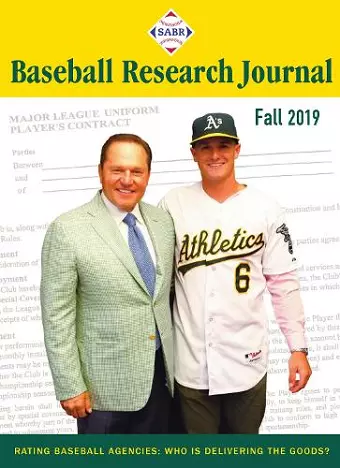Baseball Research Journal (BRJ), Volume 48 #2
Society for American Baseball Research author
Format:Paperback
Publisher:Society for American Baseball Research
Published:1st Dec '19
Currently unavailable, and unfortunately no date known when it will be back

The Fall 2019 issue of the Baseball Research Journal features voices old and new in baseball analytics and historical research. In this issue researchers tackle some of the hot issues of 2019, including analysis of defensive shifts, time of game, and comparing the metrics WAR and WAA. Photo historian Mark Rucker presents archival photos of one of Cuba's lost ballparks, matched with his own modern photos of the site.
This is the 48th year of publication for the Baseball Research Journal and this issue includes two contributors who were both in volume two, published in 1973, Art Ahrens and Pete Palmer. Ahrens delves into the life and career of Chicago Cubs hurler Carl Lundgren while Palmer revisits the history and rationale behind OPS and why it persists as a popular measure of offensive output.
Excerpts:
Philadelphia in the 1882 League Alliance
Robert D. Warrington
Histories of the Philadelphia Phillies portray the club’s admission to the National League (NL) as a straightforward and swift process.... The facts tell a different tale. Philadelphia’s journey to NL membership was complicated and protracted. The team’s participation in the 1882 League Alliance was a crucial step toward major-league status, and Alfred J. Reach’s enthusiasm for joining the NL may not have been as unbridled as depicted by some authors. This article examines the club’s entry into the Alliance, its 1882 season, and how the transition from the Alliance to the NL unfolded. It also investigates the genesis of the team’s longstanding nickname “Phillies” and questions the accuracy of the oft-told tale of how it became associated with the franchise.
“Our Lady Reporter” Introducing Some Women Baseball Writers, 1900–30
Donna L. Halper, PhD
Nearly all news and sports reporters of the early 1900s were male [and] sending a woman ... to cover a ballgame from the “feminine point of view” was considered a jolly gimmick. The headline would often mention the “lady reporter.” Readers might see headlines like this one, promoting some unique interviews about the 1912 World Series: “The heroes of the coming big baseball game personally sized up and interviewed BY A WOMAN.” [A] female reporter was expected to write a human interest story—this headline was typical: “She’s Going to Write About the Personality of Five Baseball Heroes.” Both headlines...
ISBN: 9781943816859
Dimensions: unknown
Weight: unknown
128 pages